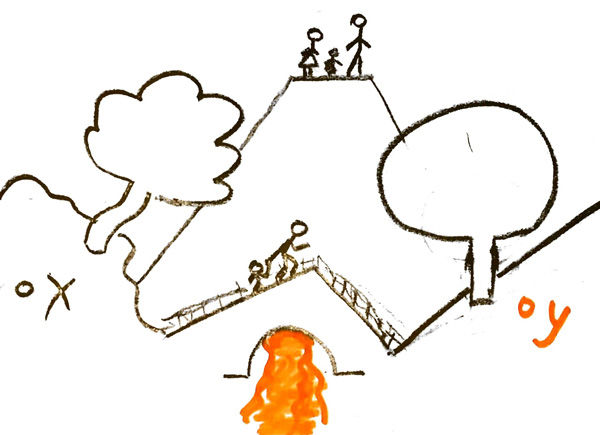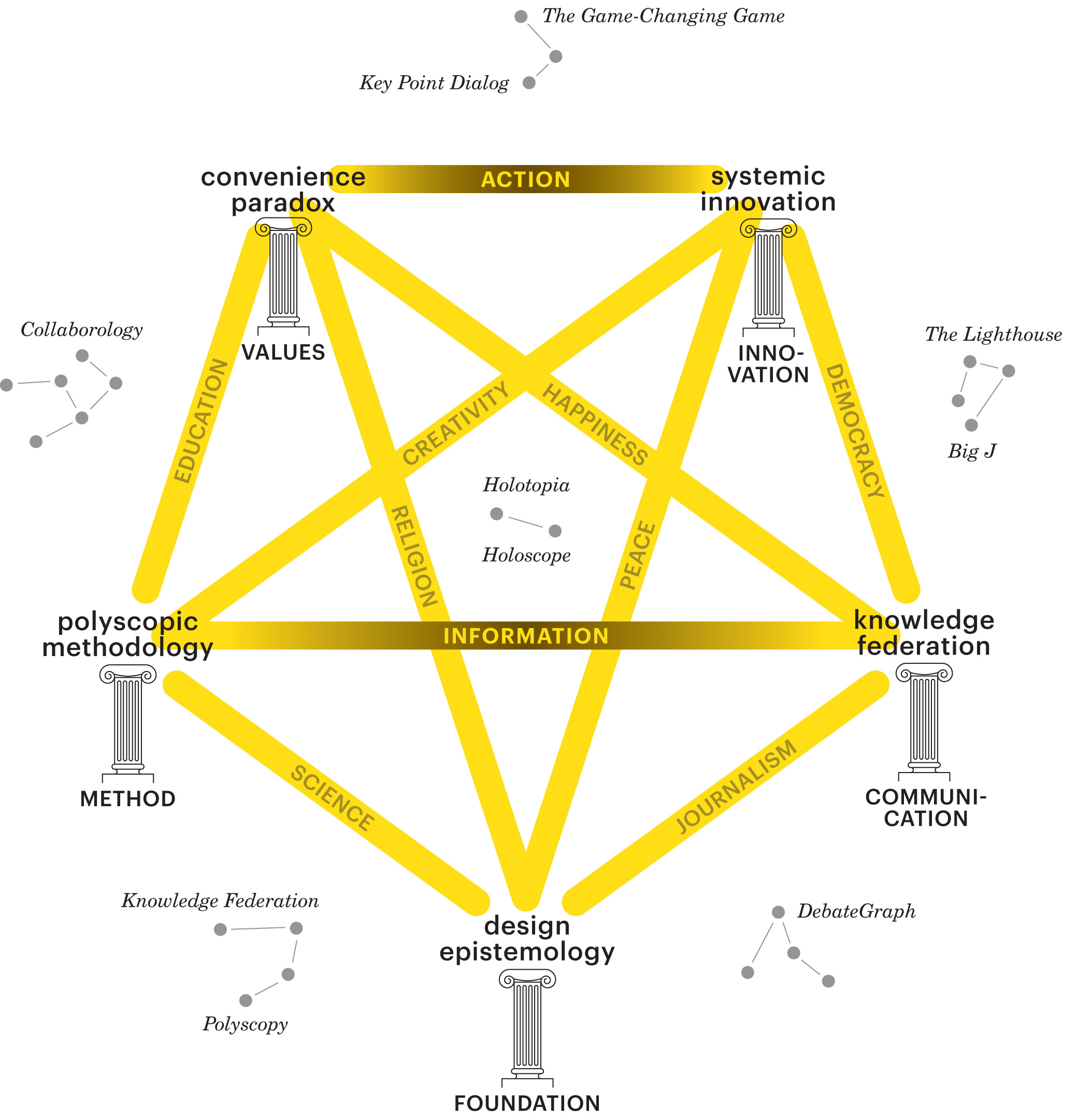Difference between revisions of "N-ideograms"
m |
m |
||
| Line 35: | Line 35: | ||
<p> [[File:KF-id.jpg]] <br><small><center>Knowledge Federation ideogram</center></small></p> | <p> [[File:KF-id.jpg]] <br><small><center>Knowledge Federation ideogram</center></small></p> | ||
<p> </p> <p> </p> | <p> </p> <p> </p> | ||
| − | |||
| − | <p> | + | <p>In <em>Autobiographical Notes</em>, Albert Einstein shared his "epistemological credo":</p> |
| + | |||
| + | <p> “I see on the one side the totality of sense experiences and, on the other, the totality of the concepts and propositions that are laid down in books. <nowiki>[…]</nowiki> The system of concepts is a creation of man, together with the rules of syntax, which constitute the structure of the conceptual system. <nowiki>[…]</nowiki> All concepts, even those closest to experience, are from the point of view of logic freely chosen posits, just as is the concept of causality, which was the point of departure for [scientific] inquiry in the first place.”</p> | ||
| + | |||
| + | <p>The Knowledge Federation ideogram comprises the <em><b>realm of experience</b></em> or "the real world" on its left, the <em><b>realm of ideas</b></em> or "the concepts and propositions that are laid down in books"on the right, and a bridge that joins them; and it also has a mountain with some stickmen in the background.</p> | ||
<p>Science gave us "the Newton's laws"; and empowered us to comprehend the natural world by a handful of simple and precise insights and principles. The aim of <em><b>knowledge federation</b></em> is to extend science into all walks of life; so that we can take <em>any</em> theme or question from the <em><b>realm of experience</b></em> over the metaphorical bridge to the <em><b>realm of ideas</b></em>—and theorize it and comprehend it; and then bring the resulting insights back over the bridge and <em>act</em> in an <em><b>informed</b></em> way.</p> | <p>Science gave us "the Newton's laws"; and empowered us to comprehend the natural world by a handful of simple and precise insights and principles. The aim of <em><b>knowledge federation</b></em> is to extend science into all walks of life; so that we can take <em>any</em> theme or question from the <em><b>realm of experience</b></em> over the metaphorical bridge to the <em><b>realm of ideas</b></em>—and theorize it and comprehend it; and then bring the resulting insights back over the bridge and <em>act</em> in an <em><b>informed</b></em> way.</p> | ||
<p>The mountain in the back stands for the <em><b>knowledge federation</b></em>'s capability to abstract further—and elevate us high <em>above</em> "the world"; by condensing a myriad academic articles and other cultural artifacts and data to simple insights; and bringing us to the metaphorical <em><b>mountain top</b></em> from which we can clearly rise above the 'trees' and see <em>directions</em>; see where the roads are leading to and which one must be followed.</p> | <p>The mountain in the back stands for the <em><b>knowledge federation</b></em>'s capability to abstract further—and elevate us high <em>above</em> "the world"; by condensing a myriad academic articles and other cultural artifacts and data to simple insights; and bringing us to the metaphorical <em><b>mountain top</b></em> from which we can clearly rise above the 'trees' and see <em>directions</em>; see where the roads are leading to and which one must be followed.</p> | ||
| + | |||
| + | |||
| + | <p>"The Matrix is the world that has been pulled over your eyes to blind you from the truth", Morpheus told Neo, introducing him to the dystopian vision of <em>The Matrix</em>; which allegorized our own world and situation, as it has become—where we try to comprehend the increasingly complex and breathtakingly fast-moving world in terms of an endless flow of images that depict it directly; and dazzle us by their very size. Long before the radio, the TV, the passenger jet, the cellular phone and the Internet, Nietzsche warned: "The <nowiki>[...]</nowiki> impressions erase each other; one instinctively resists taking in anything, taking anything deeply, to ‘digest’ anything; a weakening of the power to digest results from this. A kind of adaptation to this flood of impressions takes place: men unlearn spontaneous action, they merely react to stimuli from outside."</p> | ||
| + | |||
| + | <p>The Knowledge Federation ideogram shows "the real world" or | ||
<p></p><p></p> | <p></p><p></p> | ||
Revision as of 15:46, 24 October 2023
Contents
Federation through Ideograms
According to dictionary definition, ideograms are pictures that represent ideas; but in knowledge federation, they are a lot more than that.
An ideogram compresses "one thousand words" into an image; and makes the gist of it all recognizable at a glance.
The ideograms that are shown here are only a placeholder—for a variety of techniques that can and will be developed; by combining the expressiveness of the arts with the capabilities of new and old media technologies.
Modernity ideogram
The error is that information is not conceived of and handled in accordance to what it is—a human-made thing for human purposes; which must fulfill its functions within other human-made things—notably in the systems in which we live and work or our various institutions, including the global human society; so that they can function and be sustainable or whole.
The knowledge federation transdiscipline is a complete prototype of the socio-technical 'lightbulb'.
In One Hundred Pages for the Future, in 1981, based on a decade of The Club of Rome’s research into the future prospects of mankind, Aurelio Peccei—this global think tank’s leader and co-founder—concluded: “It is absolutely necessary to find a way to change course.”
Changing the 'headlights' by instituting transdisciplinarity is the natural way to "change course".
In his 1969 MIT report and call to action—to institute transdisciplinarity—Erich Jantsch quoted Norbert Wiener, the iconic progenitor of cybernetics:
“There is only one quality more important than ‘know-how’…… This is ‘know-what’ by which we determine not only how to accomplish our purposes, but what our purposes are to be.”
Academic disciplines cannot provide us know-what; and the media informing, such as it is, won't do it either. A system that provides us knowledge about any of the core themes of our lives and times must combine disciplinary and other evidence; it must transcend academic and cultural fragmentation; it must communicate to the public with the authority of science—in ways that are well beyond the modalities of outreach that the sciences have been able to produce.
Knowledge Federation ideogram
In Autobiographical Notes, Albert Einstein shared his "epistemological credo":
“I see on the one side the totality of sense experiences and, on the other, the totality of the concepts and propositions that are laid down in books. […] The system of concepts is a creation of man, together with the rules of syntax, which constitute the structure of the conceptual system. […] All concepts, even those closest to experience, are from the point of view of logic freely chosen posits, just as is the concept of causality, which was the point of departure for [scientific] inquiry in the first place.”
The Knowledge Federation ideogram comprises the realm of experience or "the real world" on its left, the realm of ideas or "the concepts and propositions that are laid down in books"on the right, and a bridge that joins them; and it also has a mountain with some stickmen in the background.
Science gave us "the Newton's laws"; and empowered us to comprehend the natural world by a handful of simple and precise insights and principles. The aim of knowledge federation is to extend science into all walks of life; so that we can take any theme or question from the realm of experience over the metaphorical bridge to the realm of ideas—and theorize it and comprehend it; and then bring the resulting insights back over the bridge and act in an informed way.
The mountain in the back stands for the knowledge federation's capability to abstract further—and elevate us high above "the world"; by condensing a myriad academic articles and other cultural artifacts and data to simple insights; and bringing us to the metaphorical mountain top from which we can clearly rise above the 'trees' and see directions; see where the roads are leading to and which one must be followed.
"The Matrix is the world that has been pulled over your eyes to blind you from the truth", Morpheus told Neo, introducing him to the dystopian vision of The Matrix; which allegorized our own world and situation, as it has become—where we try to comprehend the increasingly complex and breathtakingly fast-moving world in terms of an endless flow of images that depict it directly; and dazzle us by their very size. Long before the radio, the TV, the passenger jet, the cellular phone and the Internet, Nietzsche warned: "The [...] impressions erase each other; one instinctively resists taking in anything, taking anything deeply, to ‘digest’ anything; a weakening of the power to digest results from this. A kind of adaptation to this flood of impressions takes place: men unlearn spontaneous action, they merely react to stimuli from outside."
The Knowledge Federation ideogram shows "the real world" or <p>
Holotopia ideogram
The Holotopia ideogram shows that when we judiciously choose a handful of pivotal themes or categories ("pivotal" because they determine our society's evolutionary direction) and apply to them knowledge federation—we'll comprehend them and handle them completely differently than we do. And that when we elevate ourselves above "the world" by thinking in terms of basic insights and principles—we'll have a way to comprehend all other themes in completely different ways.
We'll then be able to even reach out to the stars—by creating prototypes; and organizing them into 'constellations'; and not only see a better future—but be able to create it too!



